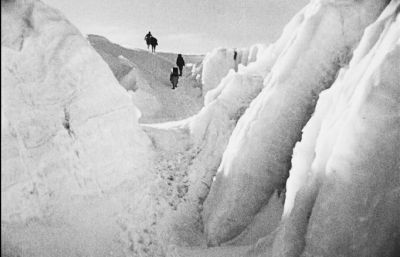
THE EPIC OF EVEREST
(Gb/1924) R.: John B.L. Noel. D.: 87'. Did. inglesi
F.: John B.L. Noel. Prod.: John B.L. Noel per Explorers Films 35mm. L.: 1989 m. D.: 89' a 20 f/s. Bn. Didascalie inglesi / English intertitles Da: BFI National Archive
Restaurato da / Restored by BFI National Archive
Introduce Bryony Dixon (BFI)
Accompagnamento al piano di Stephen Horne
"Non ci aspettiamo nessuna pietà dall'Everest" disse George Mallory all'inizio dell'ascesa finale dell'insidiosa montagna. E pietà non vi fu. La leggendaria spedizione britannica del 1924 al Monte Everest, che fu molto probabilmente il primo serio tentativo di raggiungere la vetta, ebbe come tragico epilogo la morte degli alpinisti George Mallory e Andrew Irvine. Il capitano John Noel, fotografo ufficiale della spedizione, pose l'ardua impresa al centro del magnifico The Epic of Everest, nel quale espresse anche la sua profonda fascinazione per l'allora sconosciuta terra tibetana. Il film segue il contingente di uomini, animali e attrezzature in viaggio attraverso l'altopiano e lungo il percorso registra le prime testimonianze del popolo tibetano e della sua cultura. Noel, intrepido esploratore, nel 1913 aveva tentato di arrivare all'Everest passando per il Tibet. Aveva fallito. Finanziò egli stesso il film sulla spedizione del 1924: si fece consigliare da Herbert Ponting, che aveva accompagnato Scott in Antartide, preparò una serie di attrezzature speciali (come un teleobiettivo a lungo raggio), e si costruì un laboratorio nel Darjeeling per sviluppare il materiale. In seguito girò il mondo tenendo cicli di conferenze in cui mostrava il film e le splendide diapositive a colori. Per il restauro del film ci si è basati proprio sulla copia usata nelle conferenze, conservata dalla figlia di Noel, Sandra, che l'ha donata al BFI. Le sue eccellenti condizioni hanno consentito di migliorare le sequenze danneggiate della copia originale su supporto nitrato conservata dall'archivio. Tuttavia la copia era incompleta e priva sia delle didascalie, sia dei viraggi e delle imbibizioni originali. Le copie sono state scansionate sotto liquido a una risoluzione di 4K per eliminare i graffi. È stata inoltre sviluppata una nuova tecnica per scansionare alcune scene usando i LED di un singolo colore per compensare il deterioramento del viraggio blu e i danni più gravi causati dalle muffe. Nel 1984 il capitano Noel scrisse a David Francis del BFI esprimendo l'auspicio che The Epic of Everest fosse restaurato: "Il film e i colori necessitano ancora di un consistente trattamento tecnico per diventare un film completo interamente a colori... in questo modo il film finito sarebbe degno di rappresentare una classica storia dell'esplorazione britannica e dunque meritevole di un posto negli archivi nazionali. [...] Sarei grato se il mio film potesse avere un simile destino... per la mia vita sarebbe una sorta coronamento".
Bryony Dixon
"We expect no mercy from Everest" said George Mallory as he started his final ascent of the treacherous mountain and he got none. Captain John Noel, the official photographer on the legendary 1924 British Expedition to Mount Everest, arguably the first serious attempt and famed for the tragic loss of mountaineers, George Mallory and Andrew Irvine, puts this human struggle at the heart of his magnificent film The Epic of Everest while conveying to us his fascination with the unknown land of Tibet. The film follows the large contingent of men, animals and equipment across the Tibetan Plateau towards Everest. En route it records some of the earliest images of the Tibetan people and their culture. Noel was an adventurous explorer who had tried but failed to get to Everest through Tibet, in 1913. He financed the film of the 1924 expedition himself, sought advice from Herbert Ponting who had accompanied Scott to Antarctica, and assembled special equipment such as a long range telephoto lens and even built his own lab in Darjeeling to process the reels. Later he toured extensively around the world lecturing with the film footage and beautiful colour slides. It was the film print that Noel carried around for his lectures which was the key to the film's eventual restoration, safeguarded by his daughter Sandra and donated to the BFI. Its superior condition meant the restoration team could improve damaged sequences from the archive's original nitrate print. However it was incomplete and lacked both intertitles and the film's original tints and tones. The prints were scanned at a resolution of 4K using a wet gate to eliminate scratches and a novel technique was developed to scan selected scenes using individual colour LED's to compensate for deterioration of the blue toning and the severe mould damage. In 1984 Captain Noel wrote to David Francis at the BFI, of his wishes for a restoration of The Epic of Everest. "The picture film and colour stills needed to be edited with a lot of technical treatment into a finished story film all in colour... so that the finished film would be worthy of being a classic story of British Pioneer Exploration and so be truly worthy of a place in the National Archives. [...] I would welcome this destiny for my picture... a sort of maximum attainment in my life".
Bryony Dixon

Tariffe:

Numero posti: 174
Aria Condizionata
Accesso e servizi per disabili
Il nostro cinema aderisce al circuito CinemAmico: è possibile utilizzare l’applicazione MovieReading® per i film di cui è prevista audiodescrizione e/o sottotitolazione sull'applicazione.
Tel. 051 2195311











